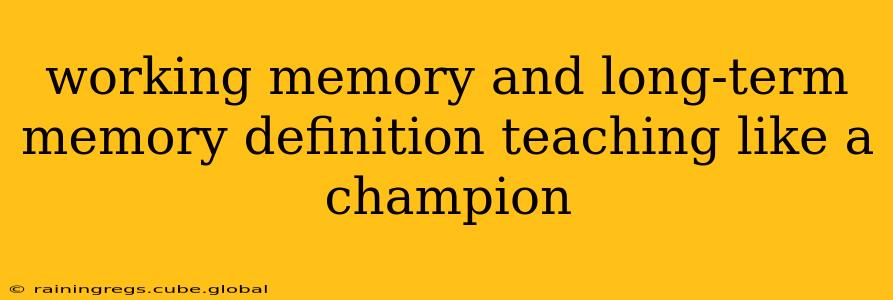Memory is the cornerstone of learning and experiencing life. But it's not a single entity; rather, it's a complex system with different components working in concert. Two crucial players in this system are working memory and long-term memory. Understanding their distinct roles and how they interact is key to unlocking your learning potential and improving your memory skills.
What is Working Memory?
Working memory isn't simply a temporary storage space; it's an active workspace where information is processed, manipulated, and integrated. Think of it as your mental "scratchpad." It holds information you're currently using – like solving a math problem, remembering a phone number long enough to dial it, or following directions. Its capacity is limited, meaning you can only hold a small amount of information at any given time. This limit is often cited as around 7 +/- 2 items, although the exact number varies depending on the type of information and individual cognitive abilities.
Key features of working memory:
- Limited capacity: It can only hold a small amount of information simultaneously.
- Active processing: Information isn't simply stored; it's actively manipulated and used.
- Temporary storage: Information is held briefly, usually only for seconds or minutes unless actively rehearsed.
- Central executive: A control system that manages the flow of information and directs attention.
What is Long-Term Memory?
Long-term memory is the vast, relatively permanent storehouse of your knowledge, experiences, skills, and memories. It's where you store everything from your childhood memories to the capital of France to how to ride a bicycle. Unlike working memory, long-term memory has a seemingly limitless capacity and can retain information for years, even decades.
Key features of long-term memory:
- Large capacity: It can store a massive amount of information.
- Long duration: Information can be stored for years, even a lifetime.
- Different types: It's divided into several sub-systems, including explicit (declarative) memory and implicit (non-declarative) memory.
- Explicit memory: This involves conscious recall of facts and events. It's further divided into episodic memory (personal experiences) and semantic memory (general knowledge).
- Implicit memory: This involves unconscious learning and memory, such as procedural memory (skills and habits).
How Do Working Memory and Long-Term Memory Interact?
Working memory and long-term memory are not isolated systems; they constantly interact. Information from long-term memory is retrieved and used in working memory, and information from working memory can be encoded and stored in long-term memory. This interaction is crucial for learning and problem-solving. For example, when you're learning a new language, you use working memory to process new vocabulary and grammar rules. Through repetition and practice, this information is then transferred to long-term memory.
How Can I Improve My Working Memory?
Improving your working memory involves strategies that enhance your ability to focus, process information efficiently, and resist distractions. Techniques include:
- Chunking: Grouping related items together to reduce the number of individual units you need to remember.
- Rehearsal: Repeating information to yourself to keep it active in working memory.
- Mnemonics: Using memory aids like acronyms or visual imagery to improve recall.
- Mindfulness and Meditation: These practices can enhance focus and attention, improving working memory capacity.
How Can I Improve My Long-Term Memory?
Strengthening your long-term memory relies on effective encoding and retrieval strategies:
- Elaborative rehearsal: Connecting new information to existing knowledge to make it more meaningful.
- Spaced repetition: Reviewing material at increasing intervals to improve retention.
- Active recall: Testing yourself on the material to strengthen memory traces.
- Sleep: Consolidation of memories happens during sleep, making it crucial for long-term retention.
What are the Differences Between Working Memory and Long-Term Memory?
The primary differences lie in their capacity, duration, and function. Working memory has limited capacity and short duration, serving as an active workspace for processing information. Long-term memory has vast capacity and long duration, storing information for later retrieval.
What are Some Examples of Working Memory in Daily Life?
Examples abound! Remembering a phone number long enough to dial it, mentally calculating the total cost of groceries, following a conversation, and understanding directions all involve working memory.
What are Some Examples of Long-Term Memory in Daily Life?
Remembering your childhood, recalling facts from history class, knowing how to ride a bike, and recognizing your friends’ faces are all examples of long-term memory at work.
By understanding the interplay between working memory and long-term memory, you can develop effective learning strategies and significantly enhance your cognitive abilities. Remember, memory is a skill that can be honed and improved with consistent practice and effective techniques.
